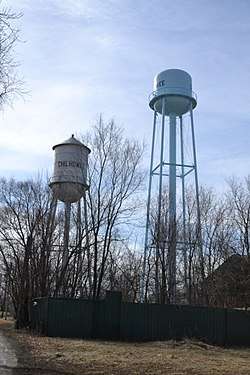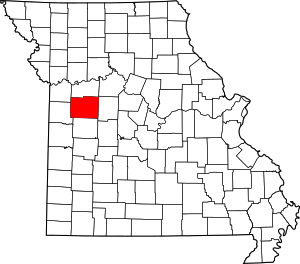Chilhowee, Missouri
Chilhowee is a city in Johnson County, Missouri, United States. It is situated along Missouri Route 2. The population was 325 at the 2010 census.
Chilhowee, Missouri | |
|---|---|
 | |
 Location of Chilhowee, Missouri | |
| Coordinates: 38°35′19″N 93°51′22″W | |
| Country | United States |
| State | Missouri |
| County | Johnson |
| Area | |
| • Total | 0.38 sq mi (0.99 km2) |
| • Land | 0.38 sq mi (0.99 km2) |
| • Water | 0.00 sq mi (0.00 km2) |
| Elevation | 922 ft (281 m) |
| Population | |
| • Total | 325 |
| • Estimate (2019)[3] | 323 |
| • Density | 843.34/sq mi (325.29/km2) |
| Time zone | UTC-6 (Central (CST)) |
| • Summer (DST) | UTC-5 (CDT) |
| ZIP code | 64733 |
| Area code(s) | 660 |
| FIPS code | 29-13654[4] |
| GNIS feature ID | 0729719[5] |
History
Chilhowee was originally called Simpson's Store, and under the latter name was founded in the mid-1850s, and named after James Simpson, a local merchant.[6] A post office called Chilhowee has been in operation since 1859.[7] The present name is of Native American origin.[8]
The Chilhowee Historic District was listed on the National Register of Historic Places in 1988.[9]
Geography
Chilhowee is located at 38°35′19″N 93°51′22″W (38.588676, -93.856190).[10]
According to the United States Census Bureau, the city has a total area of 0.38 square miles (0.98 km2), all land.[11]
Demographics
| Historical population | |||
|---|---|---|---|
| Census | Pop. | %± | |
| 1870 | 185 | — | |
| 1880 | 86 | −53.5% | |
| 1910 | 425 | — | |
| 1920 | 469 | 10.4% | |
| 1930 | 414 | −11.7% | |
| 1940 | 415 | 0.2% | |
| 1950 | 335 | −19.3% | |
| 1960 | 339 | 1.2% | |
| 1970 | 297 | −12.4% | |
| 1980 | 349 | 17.5% | |
| 1990 | 335 | −4.0% | |
| 2000 | 329 | −1.8% | |
| 2010 | 325 | −1.2% | |
| Est. 2019 | 323 | [3] | −0.6% |
| U.S. Decennial Census[12] | |||
2010 census
As of the census[2] of 2010, there were 325 people, 129 households, and 85 families living in the city. The population density was 855.3 inhabitants per square mile (330.2/km2). There were 163 housing units at an average density of 428.9 per square mile (165.6/km2). The racial makeup of the city was 95.4% White, 0.9% Native American, and 3.7% from two or more races. Hispanic or Latino of any race were 1.2% of the population.
There were 129 households, of which 36.4% had children under the age of 18 living with them, 42.6% were married couples living together, 14.0% had a female householder with no husband present, 9.3% had a male householder with no wife present, and 34.1% were non-families. 28.7% of all households were made up of individuals, and 15.5% had someone living alone who was 65 years of age or older. The average household size was 2.52 and the average family size was 3.02.
The median age in the city was 35.1 years. 29.8% of residents were under the age of 18; 7.8% were between the ages of 18 and 24; 25.6% were from 25 to 44; 21.5% were from 45 to 64; and 15.4% were 65 years of age or older. The gender makeup of the city was 50.5% male and 49.5% female.
2000 census
As of the census[4] of 2000, there were 329 people, 142 households, and 78 families living in the city. The population density was 858.6 people per square mile (334.3/km2). There were 165 housing units at an average density of 430.6 per square mile (167.6/km2). The racial makeup of the city was 95.74% White, 0.61% African American, 0.30% Native American, and 3.34% from two or more races.
There were 142 households, out of which 28.9% had children under the age of 18 living with them, 46.5% were married couples living together, 7.0% had a female householder with no husband present, and 44.4% were non-families. 39.4% of all households were made up of individuals, and 23.2% had someone living alone who was 65 years of age or older. The average household size was 2.32 and the average family size was 3.20.
In the city the population was spread out, with 26.1% under the age of 18, 9.7% from 18 to 24, 29.2% from 25 to 44, 18.2% from 45 to 64, and 16.7% who were 65 years of age or older. The median age was 37 years. For every 100 females there were 98.2 males. For every 100 females age 18 and over, there were 99.2 males.
The median income for a household in the city was $29,688, and the median income for a family was $45,938. Males had a median income of $27,500 versus $20,625 for females. The per capita income for the city was $14,850. About 4.1% of families and 9.3% of the population were below the poverty line, including 11.7% of those under age 18 and 19.2% of those age 65 or over.
Points of interest
- Rock Island Spur Trailhead
Chilhowee Fair
The annual Chilhowee Fair is the main event for which the city is best known. The city fair takes place each year on Labor Day weekend, usually beginning on Thursday evening and ending Saturday night. In 2007, Chilhowee celebrated their 60th annual fair. Fair events include arts and craft contests, vegetable and crop contests, parade, carnival, rodeo, concerts, and queen contests. The fair is highlighted by a street dance on Saturday night at the Chilhowee City Park, often called the David Hill Special. .
References
- "2019 U.S. Gazetteer Files". United States Census Bureau. Retrieved July 26, 2020.
- "U.S. Census website". United States Census Bureau. Retrieved 2012-07-08.
- "Population and Housing Unit Estimates". United States Census Bureau. May 24, 2020. Retrieved May 27, 2020.
- "U.S. Census website". United States Census Bureau. Retrieved 2008-01-31.
- "US Board on Geographic Names". United States Geological Survey. 2007-10-25. Retrieved 2008-01-31.
- "Johnson County Place Names, 1928–1945 (archived)". The State Historical Society of Missouri. Archived from the original on 24 June 2016. Retrieved 20 October 2016.CS1 maint: BOT: original-url status unknown (link)
- "Post Offices". Jim Forte Postal History. Archived from the original on 25 May 2015. Retrieved 19 October 2016.
- Bright, William (2004). Native American Placenames of the United States. University of Oklahoma Press. p. 100. ISBN 978-0-8061-3598-4.
- "National Register Information System". National Register of Historic Places. National Park Service. July 9, 2010.
- "US Gazetteer files: 2010, 2000, and 1990". United States Census Bureau. 2011-02-12. Retrieved 2011-04-23.
- "US Gazetteer files 2010". United States Census Bureau. Archived from the original on 2012-01-25. Retrieved 2012-07-08.
- "Census of Population and Housing". Census.gov. Retrieved June 4, 2015.
External links
- City of Chilhowee
- Chilhowee R-IV Schools
- Historic maps of Chilhowee in the Sanborn Maps of Missouri Collection at the University of Missouri
